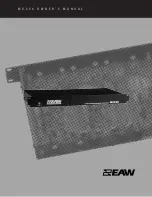
Section 150-388-124
Revision 01
Page 14
14. LOOPBACK OPERATION
14.01
The HiGain system has a family of loopback
options. The most important of these is the “Smart-
Jack” loopback which enables the HRU-412 to respond to
the standard (2/3 in 5) Smart-Jack in-band loopback codes,
and thus emulates the functions of a standard Network
Interface Device (NID). This option can be ENAbled or
DISabled from either the front panel buttons or the terminal
System Settings Menu.
14.02
In addition to the Smart-Jack loopback, the HiGain
system can be configured for one of five special in-
band loopback (SPLB) command sequences. These are
selected from the SPLB user options, which are shown in
Table 1 and Figure 11 (non-doubler applications). The non-
doubler loopback locations are shown in Figure 6.
14.03
“GNLB” is the HiGain system Generic Loopback
code. The GNLB allows in-band codes to loop up
either the HLU/NLOC (4 in 7) or the HRU/NREM (3 in 7)
toward the network. In addition, it allows in-band codes to
loop up the HLU/CREM (6 in 7) or the HRU/CLOC (5 in 7)
toward the customer. Either loop-up condition is terminated
(looped down) with the (3 in 5) loop-down code. Both in-
band codes must be present for 5 seconds before the HiGain
system responds. Table 2 lists the test procedures that apply
when using the GNLB mode.
14.04
The A1LB loopback selection complies with that
proposed for HDSL systems in the T1E1.4/92
recommendation with the following additions (see Table 3):
•
Query loopback
•
Intelligent Office Repeater (IOR) power-down
•
Three loopback time-out choices
•
Initiation from either end
•
Repeating bit error signatures
•
Alternate query loopback
These additions make A1LB identical to A2LB, but they
retain separate identities to allow future T1/E1
enhancements to A1LB without affecting A2LB.
14.05
A2LB through A5LB are four special addressable
repeater loopback functions, which are supported
by the List 2D version of the HiGain system. These
loopbacks provide the HiGain system with sophisticated
maintenance and troubleshooting tools. Table 4 through
Table 7 list the details of these SPLB functions. A2LB and
A5LB are patterned after the Teltrend addressable T1
repeater loopbacks. A3LB and A4LB are patterned after
the Wescom addressable T1 repeater loopbacks. All four
SPLBs have been enhanced to handle the specific
requirements of the following HiGain system customers:
•
A2LB (Teltrend) = Southwestern Bell
•
A3LB (Wescom) = New England Telephone
•
A4LB (Wescom Mod 1) = New York
Telephone
•
A5LB (Teltrend Mod 1) = Southern New
England Telephone (SNET)
14.06
A5LB differs from A2LB in that A5LB does not
block the arming (3 in 5) code from exiting the
HLU-388, List 2D into the network. A2LB can be
configured to either block this arming code after two
seconds and replace it with the AIS code or unblock it by
executing the Far-End Activate code. Since A5LB never
blocks the arming code from exiting the HLU-388, List 2D,
it does not need this Far-End Activate code. A3LB differs
from A4LB in that A3LB supports the additional (1 in 6)
Smart-Jack loopback command. Refer to the PairGain
HiGain-2 Intelligent Repeater Application Note #910 Part
#325-910-100 for more SPLB details.
14.07
When T1 loopback tests are performed on the
HiGain system with metallic loopback connections
at either end, the T1 code, which exists at the metallic
loopback interface, may be different from the T1 code being
received at the opposite end when the DS1 user code is set
to Auto. This is caused by the fact that, in the Auto DS1
code mode, the HLU-388, List 2D and HRU-412 set their
own codes independently of each other. Each end sets its
transmit code to match its receive code. Thus, if one end is
receiving AMI, and the other B8ZS, their codes are
different. For example, if the HRU-412 has a metallic
loopback, and the HLU-388, List 2D receive pattern code is
changed from AMI to B8ZS, and next, the all “0” pattern is
sent into the HLU-388, List 2D, then the HLU-388, List 2D
changes to its B8ZS mode while the HRU-412 remains in
its AMI mode, and thus loops all “0.” This causes the
HRU-412 to indicate an LOS condition, which causes the
HLU-388, List 2D to output the AIS pattern.















































